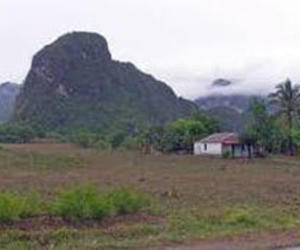Crown jewel of the Cuban countryside
- Submitted by: manso
- Travel and Tourism
- 10 / 24 / 2010

Published: Saturday | October 23, 2010. So hubby and I are up at the crack of dawn - well, more like 6 a.m. - but you can't tell because outside is as dark as midnight. We're anxious and excited about venturing into the Cuban countryside. We have to meet the tour bus by 7:30 a.m.,so the rush is on to get ready, have breakfast and be in the lobby of El Bosque Hotel before 7:20 a.m. By 8 a.m., we're on our way!
Our destination? Pinar del Rio, a province at the westernmost end of Cuba. Famous for its natural beauty, flora and fauna, Pinar del Rio, or Pine Forest of the River, is an ideal spot for ecotourism. Thousands of tourists make the journey to this section of Cuba each year, admiring rare birds such as the Cuban trogon, or tocororo (the national bird), plants such as the cork palm, traversing caves like Cueva del Indio, viewing the chalky Mogotes hills and visiting the must-see Mural of Prehistory.
We pull into the town of Pinar del Rio and we're immediately fascinated by its simplicity. Traffic - a colourful blend of vintage and modern cars, horse-drawn buggies, motorbike and tricycle taxis - is smooth-flowing, despite how busy it looks. The horse-drawn buggies, with six to eight passengers, are as much a part of traffic as our huge tour bus. The power of the pedestrian crossing is respected and locals make their way to work, slowly but surely.
Our first tour of the day is at the tobacco factory, Fabrica de Tobaco Francisco Donatien. This is expected because Pinar del Rio is the capital of Cuban tobacco cultivation. At the factory, we observe workers manually selecting and sorting the best leaves, and making and packaging the cigars. No cameras are allowed, and the tour ends in 20 minutes.
Guayabita del Pinar
We skip from the tobacco factory into the Guayabita del Pinar Distillery, where the Guayabita rum is manually made, bottled by machines and labelled by workers. This is the only place in Cuba where this type of rum is made. Our tour guide, Roberto, explains that the Guayabita, small, green guavas, are soaked for 30 days in barrels of alcohol made from sugar cane. When that's done, the rum is bottled (with one or two fresh guavas inside as part of its signature) and shipped for sale.
Thirty minutes of driving takes us from the town centre into the rustic parts of Pinar del Rio. Here is where nature takes over. Everywhere we look, there is colour and life. Green trees and fields of tobacco, massive mountains, blue skies, scarved schoolboys and burgundy-skirted schoolgirls, strong, horned oxen ploughing fields, farmers making their way to barns, more horse-drawn buggies and bike and tricycle taxis. And it's all done in an easy-going manner - no fuss or apparent rush. The life and movement pulls you in, awes you and speaks volumes about rural life in Pinar del Rio.
We head to Viñales Valley, where we are surrounded by Mogotes. Mogotes are limestone hill formations covered by vegetation and palm trees. Otherwise called pin-cushion hills, the Mogotes are rounded hills with flat tops and vertical slopes. In one of the Mogotes, known as Dos Hermanas (Two Sisters), we meet upon a breathtaking piece of art - the Mural of Prehistory. The largest outdoor painting in Cuba, it is a representation of the biological evolution of Sierra de los Organos. Measuring 120m high by 180m wide, the mural was done under the guidance of Cuban Professor Leovigildo González.
tranquility reigns
As we head deeper into the valley, tranquility reigns supreme. We note that the agricultural lifestyle of the people is complement to the lush vegetation of the natural landscape. No heavy machinery is in sight; all work done on the farms is done using ancient farming methods: oxen, cows, horses and machetes resembling hockey sticks. Quaint, tiny, fenceless, colourful homes dot the countryside. The rich, red soil contrasts the well-asphalted streets (no potholes) but blends into the natural landscape.
We stop and meet Benito, a farmer. He takes us through the process of drying tobacco leaves, and even makes cigars for each member of our tour party. His wife provides strong Cuban coffee and visitors get a chance to feed the chickens and turkeys he rears on his farm.
Our last stop takes us into San Vicente, where we head off to tour the Cueva del Indio, or Indian Cave. The entrance is small, and as we go deeper into the cave, the walls widen just a bit. Hubby and I tread carefully, as the limestone rocks are slippery because of water dripping from threatening stalactites. At one point, we had to stoop and squeeze through a narrow passage to get to the other side of the cave. It was a bit claustrophobic, but the journey was short, and we knew we had to do it; if we didn't, we would miss the boat ride that would take us out of the cave and to our lunch!
The boat ride was wonderful. It was about 15 minutes from boarding point to the cave's exit, but it was an awesome 15 minutes. The San Vicente River, which runs through the cave, lazily took us up close to limestone formations that were eerily reminiscent of creatures from prehistoric times and from horror movies. The cool air made for a comfortable ride, as the boat was loaded with 16 persons, two tour guides included.
The tour ended with us lunching at the San Vicente Restaurant, and doing last-minute shopping at the craft store on the property.
It was hard to take leave of the valley, of Pinar del Rio, but the rest of Havana awaited our exploration!
[email protected]
Source: www.jamaica-gleaner.com/gleaner/20101023/lead/lead7.html
Comments